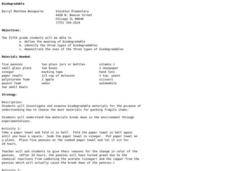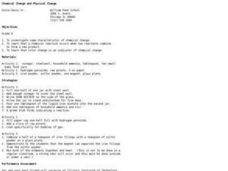Curated OER
Baking Soda and Vinegar Chemical Reaction
Students conduct experiments by mixing baking soda and vinegar. In this chemistry lesson, students complete three different experiments involving these two substances. They find that the chemical reaction does not change and will be...
Curated OER
Keep it Bottled Up: Linear Rates of Pressure Increase
Pupils explore linear functions in this lesson when they collect and analyze data as a chemical reaction proceeds. Learners record pressure versus time data and model the data as a linear function. They also examine the concept of slope...
Curated OER
Shaving Cream Art
Students participate in paper marbling. In this paper art lesson, students use shaving cream and paint to create unique patterns on paper. Students mix shaving cream and paint together then lay paper down in the mix. The paper is allowed...
Curated OER
Chemical Equations and Symbols
In this chemical equations and symbols worksheet, students are given two written equations and they translate each into chemical symbols. They are given two equations with chemical symbols and they translate them into written equations.
Curated OER
Chemistry: Chemical Reactions
Students investigate chemical reactions. In this chemistry lesson, students burn magnesium and record the mass. Students list five chemical reactions they see everyday.
Curated OER
What Happens When Chemicals are Put Together?
In this chemical reactions worksheet, students answer 12 multiple choice questions about compounds, chemical reactions, and balancing equations using coefficients.
Curated OER
Ice Energy
Students investigate how salt affects the state of ice. In this ice cream making lesson, students change the freezing temperature by adding salt and observing the results. Students use experimentation and comparison to see how chemicals...
Curated OER
Ice Energy
Students study the concept of ice energy. In this ice energy lesson, students observe what happens when salt is sprinkled on a piece of ice before following a recipe to make two types of ice cream. They note the difference in the two...
Curated OER
Reactions of Metals with Water, Acid and Air
In this chemical reactions worksheet, students experiment with reactions between 4 different metals with water, acid and air. Students make observations of copper, iron, zinc and magnesium with water, acid and air. They write an analysis...
Curated OER
The Reaction Between Magnesium and Hydrochloric Acid
In this rate of chemical reactions worksheet, learners experiment with different concentrations and volumes of hydrochloric acid mixed with magnesium. They measure the rates of the reactions and analyze their results from a graph they...
Curated OER
Rusting, Burning and Oxygen
In this rusting, burning and oxygen instructional activity, students read about chemical reactions and are given diagrams of a rusting bicycle, a burning candle, and a variety of chemical changes. Students make observations and explain...
Curated OER
The Role of Enzymes
Learners explore the role of enzymes in chemical reactions. In this enzymes lesson plan, students use hydrogen peroxide and manganese dioxide to observe a chemical reaction. Learners observe the rates of reactions of chalk, hamburger,...
Curated OER
Making Compounds
In this compounds learning exercise, students draw the compound that is produced in the given chemical reactions. This learning exercise has 20 problems to solve.
Curated OER
Candy Reaction
In this triboluminescence worksheet, young scholars use wint-o-green Lifesavers to observe a chemical reaction that gives off light. They break a lifesaver up with a hammer and make observations and they chew a lifesaver and make...
Curated OER
Conservation of Mass
In this conservation of mass worksheet, students design an investigation to demonstrate the Law of Conservation of Mass. Students describe their investigation, collect data, graph the data and write a conclusion about what they discovered.
Curated OER
Chemical Changes in Matter
In this matter and chemical changes activity, students write symbols and formulas for 2 chemical reactions. They write words for 1 chemical reaction given in symbols and formulas. They draw a diagram representing a chemical reaction and...
Curated OER
Biodegradable
Fifth graders experiment with biodegradable materials. In this science lesson, 5th graders perform a series of experiments, then discuss and chart their observations. Through the experiments, students will be able to identify three types...
Curated OER
The "Clock Reaction" Kinetics Lab
Students investigate the effects of temperature and concentration on the rate of reactions. In this "clock reaction" kinetics lesson plan, students change the concentration of one reactant and keep the second constant. An indicator is...
Curated OER
Coke, Soda, Hot VS. Cold
First graders explore chemical reactions in hot bottled soda and cold bottled soda. In this lesson about chemical reactions, 1st graders observe an experiment and discuss the results as a class. Students determine why bubbles are...
Curated OER
Cleaning of Metal
Young scholars clean pennies and determine why one substance cleans better. In this lesson about acids and bases, students experiment how to clean a penny. Young scholars use four different solutions to clean their pennies. Students will...
Curated OER
Chemical Change and Physical Change
Sixth graders combine chemicals to create a chemical change. In this chemicals lesson plan, 6th graders will investigate characteristics of chemical change by combining chemicals. They will learn that color change is an indicator of...
Curated OER
Writing the Complete Equation
In this writing equations worksheet, students are given 6 chemical reactions and they write equations for each one including the reactants, the products and the states of matter.
Curated OER
Another Balancing Equations Sheet
In this reactions worksheet, students balance the reactants and products for the given chemical reactions. This worksheet has 15 problems to solve.
Curated OER
Understanding Chemical Equations
In this chemical equations worksheet, students identify the reactants and the products, state what phase each is in, and state the mole ratios of all the products and reactants. Students complete 10 problems.

























